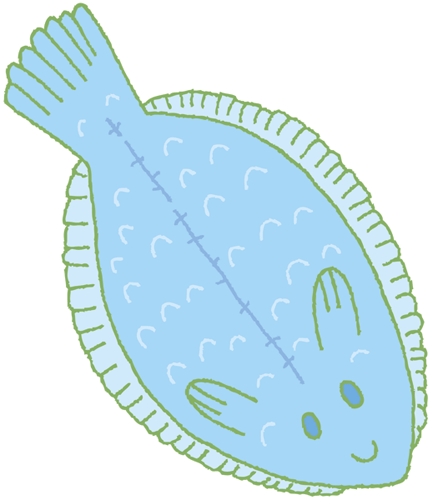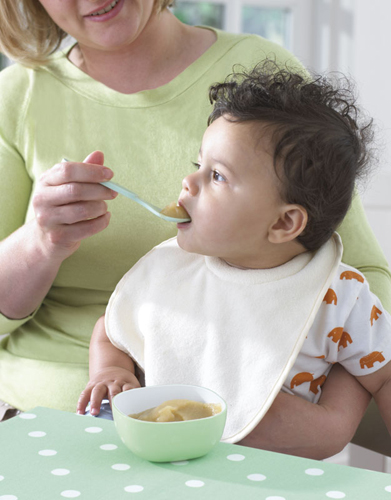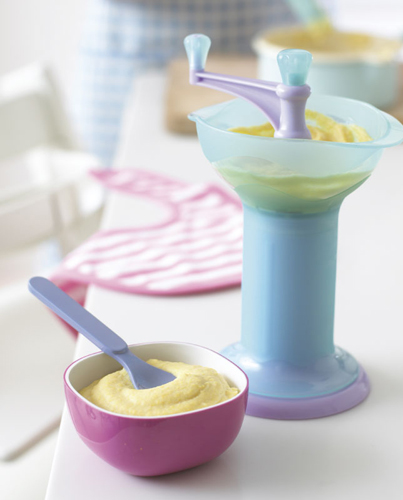Finger foods
Melt in the mouth:
Steamed soft carrot sticks, broccoli, and cauliflower florets Pear, banana, apple, blueberries, mango, peach, strawberries Avocado
Bite and chew:
Oven-baked potato or sweet potato wedges Cucumber sticks Cheese, cut into sticks Small chunks of fish or chicken Dried apricots and apple rings
Did you know…
that many babies who
refuse lumpy foods will happily chew on finger foods? Introducing
lumpier textures can be a stressful time for parents, but don’t despair,
because if your baby is chewing on finger foods, this means he can
easily cope with lumpier textures. The muscles a baby uses to chew are
the same ones used for speech, so encouraging your baby to chew will
help his speech development too. See the finger food.

Sole, Sweet Potato, and Broccoli Purée
When introducing fish to babies, I like to start with something like sole because it is very tender and mild. Here I combine it with sweet vegetables, which should help to tempt the tastebuds. You can also substitute salmon for the white fish.


8 minutes
6–8 minutes
1/2 sweet potato (about 7oz), peeled and cut into small dice 2 broccoli florets (about 11/2oz in total), cut into small pieces 4oz sole or other white fish fillet, skinned and cut into little-finger size strips 1/4 cup milk 2 tbsp shredded Gruyère or Emmental cheese
Spread out the
sweet potato and broccoli in a steamer (or use a metal colander set over
a pan of simmering water). Cover and steam until really tender, 6–8
minutes.
Meanwhile, put the fish
into a small saucepan, cover with the milk, and cook until it flakes
easily, about 2 minutes. Remove from the heat and stir in the cheese
until melted. Put the vegetables and fish mixture in a blender or baby
foodmill and purée. Add a little more milk, if necessary.
Cool as quickly as
possible (put the purée in a glass bowl set in a second bowl of ice and
stir for 4–5 minutes), then cover and refrigerate. Or, freeze in
individual portions; when needed, thaw overnight in the refrigerator.
To serve, heat
the purée in a microwave or small saucepan until piping hot, stirring
occasionally and adding a little more milk if necessary. Cool to warm
and check the temperature before serving.
Creamy Apple and Oat Purée
Choose sweet apples to make a sweet applesauce, with plenty of nutrients and healthy fiber. Oats make a great addition to your baby’s diet; they are packed with vitamins, minerals, and essential fatty acids. Best of all, they help to stabilize your baby’s blood sugar levels, keeping him calm and full of energy.
7 minutes
10–15 minutes
NOTE
About 8 baby portions
3 sweet apples, peeled, cored, and thinly sliced 2 tbsp water Pinch of ground cinnamon (optional) 1 tsp agave nectar (optional—to add more sweetness) Per portion
Put the apples in a
saucepan with the water. Bring to a boil, then reduce the heat, cover,
and cook very gently until soft, 10–15 minutes.
Add the cinnamon, if
using, and purée in a blender, or mash until smooth. Sweeten with the
agave nectar, if using. Cool the applesauce and keep refrigerated until
needed, or freeze in individual portions and thaw as required.
To serve, warm one
portion (approx. 2 tbsp) of the applesauce and stir in the oats and
milk. Cool slightly and check the temperature before serving.
Chicken and Corn Chowder
Chicken is a good first meat for babies since it is tender and has a mild flavor. Mixing it with corn in a smooth chowder is a clever way to introduce chicken to your baby. Another good combination is chicken with sweet potatoes and apple.

10 minutes
10 minutes
1 skinless, boneless chicken breast, cut into 3/4in cubes 11/4 cups canned naturally-sweet corn packed in water, drained 1/3 cup water 1 potato, peeled and diced 1–2 tbsp breast milk or formula
Put the chicken,
corn, and measured water in a small heatproof bowl and set the bowl in a
large saucepan. Put the diced potato in the saucepan alongside the
bowl. Pour boiling water over the potatoes in the pan so the water comes
halfway up the sides of the bowl. Bring the water back to a boil, then
reduce the heat, cover, and cook until the potato and the chicken are
cooked through, about 10 minutes.
Lift the bowl out of
the pan. Drain the potatoes and put them in a baby foodmill set over a
bowl. Add the chicken, corn, and cooking liquid from the bowl and purée
the mixture (puréeing with a foodmill will get rid of the skins from the
corn; if you use a blender, you will have to press the mixture through a
sieve after puréeing). Add a little milk, if necessary, to make a soft,
smooth consistency. Cool quickly, then refrigerate. Or, freeze in
individual portions; thaw overnight in the refrigerator as needed.
To serve, heat in a saucepan or microwave until piping hot. Let cool slightly, and check the temperature before serving.
|